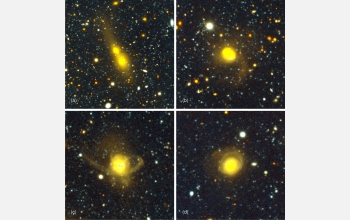News Release 05-207
Galaxy Collisions Dominate the Universe
Massive galaxies form by mergers
December 7, 2005
This material is available primarily for archival purposes. Telephone numbers or other contact information may be out of date; please see current contact information at media contacts.
A study using hundreds of images from two of the deepest sky surveys ever conducted has confirmed what astronomers have long suspected: no galaxy is an island.
Quite the opposite, says Yale astronomer Pieter van Dokkum, lead author of the survey team's report in the Dec. 2005 issue of the Astronomical Journal. Galaxies are in constant interaction with one another. Indeed, that's how theorists believe most galaxies formed in the first place, with the big ones getting bigger through the collision and merger of smaller ones.
For a long time, van Dokkum adds, the only exceptions seemed to be the giant elliptical galaxies. These immense, featureless blobs not only contain some of the oldest stars in the universe, but look as if nothing had disturbed them for many billions of years, since shortly after the big bang.
Now, closer examination tells a different story. Using data from two recent deep surveys done with the National Science Foundation's 4-meter telescopes at Kitt Peak National Observatory and Cerro Tololo Inter-American Observatory, known as the NOAO Deep Wide-Field Survey and the Multiwavelength Survey by Yale/Chile, van Dokkum an his colleagues find that 53 percent of the elliptical galaxies in their sample show complex tails and streamers of stars--the classic signs of galaxies in collision.
"Our study found these common massive galaxies do form by mergers," says van Dokkum. "It is just that the mergers happen quickly, and the features that reveal the mergers are very faint and therefore difficult to detect."
For more information, see the news release from the National Optical Astronomy Observatory.
-NSF-
Media Contacts
Douglas Isbell, NOAO, (520) 318-8214, email: disbell@noao.edu
M. Mitchell Waldrop, NSF, (703) 292-7752, email: mwaldrop@nsf.gov
Janet Rettig Emanuel, Yale University, 203) 432-2157, email: janet.emanuel@yale.edu
Principal Investigators
Pieter van Dokkum, Yale University, (203) 432-3019, email: dokkum@astro.yale.edu
Related Websites
Yale news release: http://www.yale.edu/opa/newsr/05-12-06-01.all.html
Images, animation of galaxy growth, and published paper: http://www.astro.yale.edu/dokkum/mergers/
The U.S. National Science Foundation propels the nation forward by advancing fundamental research in all fields of science and engineering. NSF supports research and people by providing facilities, instruments and funding to support their ingenuity and sustain the U.S. as a global leader in research and innovation. With a fiscal year 2023 budget of $9.5 billion, NSF funds reach all 50 states through grants to nearly 2,000 colleges, universities and institutions. Each year, NSF receives more than 40,000 competitive proposals and makes about 11,000 new awards. Those awards include support for cooperative research with industry, Arctic and Antarctic research and operations, and U.S. participation in international scientific efforts.
Connect with us online
NSF website: nsf.gov
NSF News: nsf.gov/news
For News Media: nsf.gov/news/newsroom
Statistics: nsf.gov/statistics/
Awards database: nsf.gov/awardsearch/
Follow us on social
Twitter: twitter.com/NSF
Facebook: facebook.com/US.NSF
Instagram: instagram.com/nsfgov



